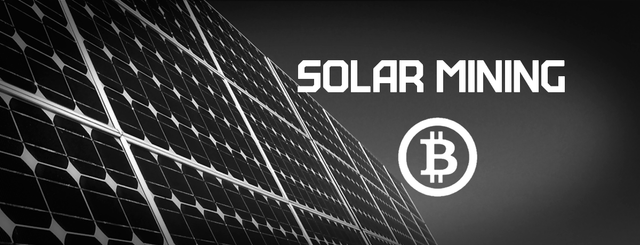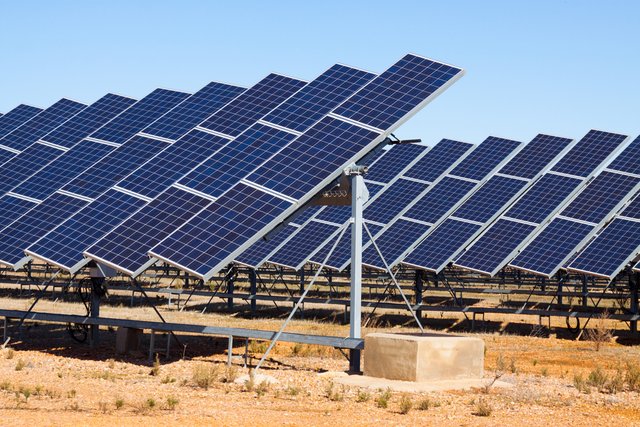Is a Solar Powered Mining Rig The Wave Of The Future?
With Bitcoin and other virtual coins reaching all time highs, the general public has been getting more and more interested in mining.
In general, however, it is a very costly endeavor.
First you have to pay for the mining rig, then you have mining pool fees, and then you have to pay for the massive amounts of electricity you use each month.
In most cases people can make very little from running Bitcoin mining rigs unless they live in a place where electricity is very cheap or they only do it when the price of Bitcoin is very high. Like it is now.
Apart from the upfront cost for the equipment, the monthly utility bill is the biggest drain on mining profits...
What if we could find a way to take the monthly electricity expense out of the equation?
That is precisely what solar powered mining rigs aim to do.
So far, mining operations that use solar panels are finding that it is a good investment. Sort of. There is a large upfront cost but once that is paid for, the cost of mining is "virtually" free. (as you know nothing in life is free and there are still mining pool fees)
Either way, in most cases the biggest hurdle to mining profitably is the large electricity bill each month. This method hopes to navigate around it.
I recently read about a miner out in the desert doing this profitably.
The desert miner's operation has been running for almost a year and currently uses 25 computing rigs. Each rig cost about $8,000 to set up.
More about him specifically can be read here:
https://themerkle.com/will-mining-cryptocurrency-in-the-desert-using-solar-power-make-you-rich/
His start up costs might be more than most can stomach, but perhaps they can be emulated on a smaller scale?
That costs mentioned include the solar panels, power controls, batteries, and the Antminer S9 ASIC processor.
Doing some quick calculations we can see that he spent $8000 x 25 rigs(there wasn't any mention of mining pool fees in the article) for a total of $200,000.
Quite a large chunk of change.
How profitable is it?
According to the miner, each rig brings in roughly $18 per day, varying slightly depending on the price of Bitcoin each day.
Again, doing some quick calculations we can see that $18 x 25 = $450 dollars per day. With 365 days in a year we can see that $450 x 365 = $164,250 per year in income.
Therefore the miner can expect to pay for his entire investment in roughly 1 and a quarter years, or about 15 months. Not ideal but it appears our miner is playing the long game here. Everything earned after break even is mostly profits with this method.
However there are some major caveats...
- He has mining pool fees that are not mentioned here.
- He has to keep the equipment cool somehow, likely housing them in some form of shelter while also keeping them cool.
- The price of Bitcoin needs to remain high. Likely over that $2000 number. The lower it drops the longer it will take for him to break even on his investment.
Given all of this, the desert miner has major plans for expansion.
The desert miner claims that he is thinking of adding roughly 1000 more solar powered mining rigs because of how successful he views it has been on a smaller scale.
He stated that he needs Bitcoin to stay above $2,000 per coin to remain profitable, however, if all the costs are upfront I am not sure what he means by that...
It looks like no matter what it could be profitable, it just will take more and more time to reach profitability depending on how low Bitcoin were to fall.
Conversely it would happen much faster if Bitcoin were to rise in price.
Also failed to be mentioned by the miner in the article, but there is the worry that the computer equipment could get too hot out there in the desert.
So, while the solar panels will do fine in the heat, some of the other equipment not so much. Perhaps some of that power being generated will have to be used to power a fan to cool some of the equipment?
Either way it sounds like a very interesting idea and one I am looking into further living out here in the desert myself.
Stay informed my friends!
Sources:
https://themerkle.com/this-solar-mill-powers-a-small-bitcoin-mining-operation/
http://www.investopedia.com/news/solarpowered-cryptocurrency-mining-next-big-thing/
Image Sources:
https://blog.cex.io/cryptonews/solar-bitcoin-mining-1841
https://themerkle.com/this-solar-mill-powers-a-small-bitcoin-mining-operation/
https://themerkle.com/will-mining-cryptocurrency-in-the-desert-using-solar-power-make-you-rich/
Follow me: @jrcornel



Only read the title and here is your answer,,, No, Electricity is electricity, producing electricity using solar panel is nearly the most expensive kind you can get. Since mining can be done anywhere where cheaper source of electricity is available this will NEVER be profitable.
imho, never say never when speaking of technology
Your information is a little out of date - solar is now the cheapest form of new electricity generation.
The link quotes a Bloomberg analyst:
What about cloudy days? What about multiple days without significant sunlight?
I am assuming the power would be stored on a battery for such occasions, like other solar set ups.
Solar powered mining could only get profitable when photovoltaic cells drop drastically in price. This will eventually happen when more people invest in solar energy which improves the competition of technological advances.
The cost per watt for panels has come down significantly and will continue to do so. Panels are relatively cheap but what is expensive is the "balance of system" electrical equip.(inverters/batteries/charge controllers, etc.) and installation labor.
I would imagine that he has a deep hole in the dessert where he stores his mining gear to minimize cooling costs? Kind of a geo-thermal thing if you will?
#payitforward
Additionally, the desert nights are known to be very cold, which could offset the heating costs due to the natural low temperature of the surrounding air. That said though, the obvious factor that the solar arrays would not be being powered during the night would necessitate large batteries in order to keep the energy stored for night time mining. Possibly the set-up would be arranged to work at reduced capacity during the day, so the systems would not overheat and the batteries could be charged, and run a full power at night, using the natural coldness of the desert to keep temperatures low and running off of battery power. This would mean unequal performance throughout the day, but it would most likely be necessary to work in the desert environment.
Haha that is funny! Poor Granny....
If he is using Antminers, I also question the resale value of these
once they are no longer profitable. Probably zero I'm betting.
Is he mining Ethereum and what happens when it moves to POS ?
Will he have to move to mining less profitable coins ?
I like the green aspect but for the time being, very risky.
I enjoyed the read, gave me an idea on how much a small mining operation really cost.
I think this is a great crypto currency investment post. As people are looking more and more toward sustainable businesses it's a good idea to look into crypto, which uses solar power to offset electricity usage. It's also a good idea to look at the complexity of the crypto's algorithm. The more complex, the more energy warranted to carry out the transactions completed on the block chain. My post THE CRYPTO KEEPER: MINE YO DAMN CRYPTO provides some info on electricity and mining. Once again, great post.
well now that was interesting
how about using thermal energy alongside solar?https://steemit.com/mining/@quantumpoker/a-neat-trick-to-reduce-energy-cost-for-miners